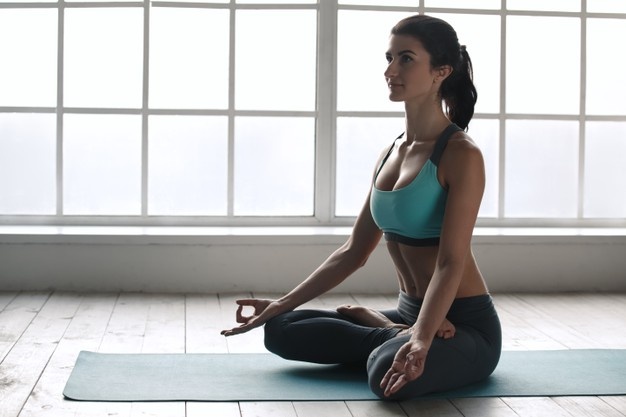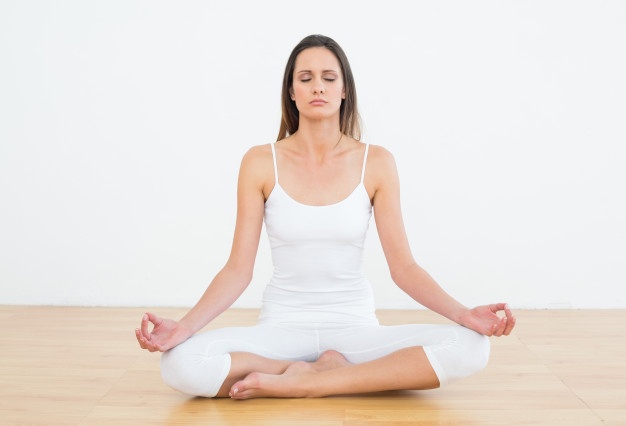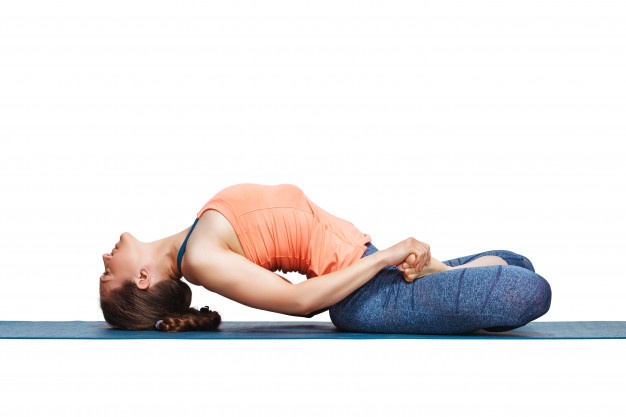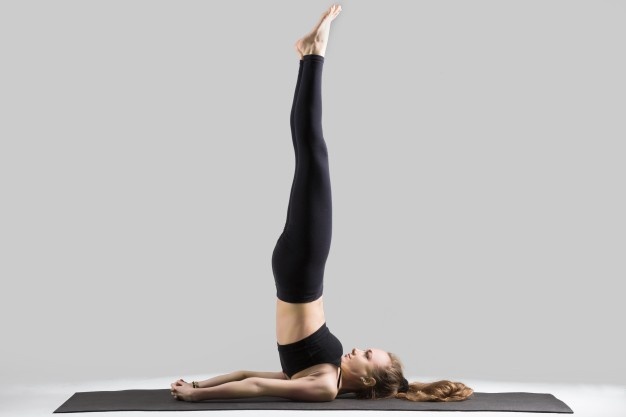Yoga is a holistic practice, meant to rejuvenate your mind and body. Many people have incorporated yoga in their daily routine, realizing the myriad health benefits it offers. Today, people are using pranayama for thyroid as a tool to alleviate an array of health-related issues.
Yoga for Thyroid Cure
Today, many people are suffering from thyroid issues attributed to poor lifestyle choices. People are dependent on medicines life- long to keep their thyroid levels under check. There are techniques for thyroid control as well, but not many people are aware that pranayama for thyroid can cure by altering its adverse effects. In fact, regular practice of pranayama and yogic postures can help thyroid gland function properly.
Hypothyroidism vs Hyperthyroidism
Thyroid is a butterfly-shaped endocrine gland found at the base of the neck in all humans. Its main function is to regulate metabolism and blood sugar levels in your body. When it fails to function well, it can cause either hypothyroidism or hyperthyroidism.
Hypothyroidism is a condition in which your thyroid gland becomes underactive and stops secreting enough thyroid hormones. Your body’s metabolism slows down, and you will witness a range of symptoms, such as fatigue, dullness, poor memory, weight gain, dry skin and constipation.
Hyperthyroidism, on the other hand, occurs when your thyroid gland produces excessive thyroid hormones. The symptoms include weight loss, accelerated heart rate, irritability, anxiety, and so on.
Are you experiencing the above symptoms? Worry not, as we have come up with a list of yogic techniques for thyroid control that include pranayama techniques and yogic postures.
Thyroid Control with Pranayama
Pranayama is all about learning to control your Prana – the vital life-force that influences all your activities and fuels the functions of your body. Poor lifestyle and unhealthy dietary habits, as well as stress, obstruct the flow of Prana in your body. This depletes all your energies, leading to poor metabolic function and malaise in your body.
But there are exercises in pranayama for thyroid control that reverse the symptoms of the thyroid and rejuvenate all the cells and the organs in your body. These exercises are effective in slowing down your breathing, increasing your body’s metabolism and balancing your blood sugar levels. Certain Pranayama yoga for thyroid need constriction and stretching of the larynx in your throat. This stimulates the thyroid gland, making it function better.
Instructions for Thyroid Pranayama Practice
Thyroid control by pranayama is effective if you follow the instructions given below.
- Pranayama should not be practised on a bare floor. Spread a yoga mat, a blanket or a rug, and practise on it.
- Ensure that your bowels and bladder are empty before practicing the Pranayama kriya. Ideally, Pranayama should be practised in the morning on an empty stomach.
- Pranayama should follow the practice of asanas. Asanas involve exertion of muscles and tissues due to the bodily movements, while Pranayama soothes all your nerves and relaxes your muscles.
- Have your meal after a gap of half-an-hour to one hour after the Pranayama exercises.
- Keep your eyes closed during the practice, or else your mind will wander and get distracted.
- Do not flex your facial or neck muscles while doing the Pranayama, and keep your thighs, feet and hands relaxed.
- Lie down in Shavasana for at least 5-10 minutes in silence after you perform Pranayama, as it refreshes your mind and body.
6 Best exercises in Pranayama for Thyroid Cure
(1) Bhastrika
This Pranayama is so named, as it resembles the action of a Bhastra or ‘the bellows’. It involves forced inhalation and exhalation, which generates heat in your body and helps stimulate blood circulation and flush out toxins. It is also one of the best exercises in Pranayama for thyroid problem, as it alleviates the inflammation in your throat and activates the thyroid gland.

Steps:
- Sit comfortably in Padmasana (Lotus Pose) or Siddhasana(Perfect Pose).
- Draw in a deep breath.
- Exhale quickly and forcefully through both the nostrils, and then inhale in with same force.
- When you exhale, retract your abdomen and diaphragm and relax them as you inhale.
- Continue this method to a count of ten.
- At the end of ten breaths, observe normal breathing and relax.
(2) Kapalabathi
Kapalbhati is the best Pranayama for thyroid. It is indeed one of the Shatkarmas or Shatkriyas, the preliminary techniques used for the purification of the body. It is also known as ‘the skull-shining’ Pranayama. This Pranayama is slightly different from Bhastrika, in that the inhalation is passive and the exhalation is done forcefully. This Pranayama has a range of benefits, including the stimulation of the underactive thyroid gland. It oxygenates the cells in the body, regulates the digestive system and improves the functions of kidneys and liver.

(Pic Credit – Healthshots)
Steps:
- Sit in a comfortable position, either in Padmasana (Lotus Pose) or in Siddhasana(Perfect Pose).
- Keep your spine straight and head slightly bent.
- Place your hands on your knees with your palms facing downwards.
- Draw in a short breath and then exhale forcefully and quickly.
- When you exhale, retract your stomach as much as you can. Feel the contraction happening.
- The inhalation and exhalation should be rapid. Practice at least 20 rounds.
- Relax your hands and feel the sensations in your body.
(3) Ujjayi Pranayama
Ujjayi is the process in which the lungs get expanded and the chest is puffed out fully, like that of a proud warrior. This is yet another technique for effective thyroid control with Pranayama, as it treats any imbalance in the thyroid levels. It is also known as ‘the ocean breathing technique’, as when you inhale and exhale, constricting your glottis, you will hear a well-modulated hissing sound, like that of the sound in the ocean waves. Apart from being the best Pranayama for thyroid cure, Ujjayi also helps in supplying enough oxygen to the lungs, removing phlegm and calming your nerves and mind.

Steps:
- Sit in a comfortable position like Padmasana (Lotus Pose) or Siddhasana(Perfect Pose).
- Keep your spine straight and bend your head slightly towards the trunk.
- Place your hands on your knees with palms facing upwards.
- Hold the Gyana Mudra by joining the tips of your index fingers to the tips of your thumbs.
- Close your eyes and constrict your glottis.
- Breathe out gently until your lungs become empty.
- Now draw in a slow, steady, rhythmic breath through both the nostrils.
- Feel the air pass through the constricted throat, and feel the hissing sound produced.
- Fill your lungs up to the brim, and do not extend your abdomen during the process.
- Hold your breath for a second or two.
- Now, breathe out slowly and steadily until your lungs become empty.
- After exhaling, relax the diaphragm gradually.
- Wait for a second or two before you draw in a fresh breath.
- Repeat the above cycle for five or six times.
- The flow of breath should be slow, smooth and natural.
(4) Nadi Shodhana Pranayama
‘Nadis’ are the subtle energy channels in our body, and ‘Shodhana’ denotes ‘purifying’ or ‘cleansing’ in Sanskrit. A slight obstruction in the energy channels can cause discomfort, leading to various ailments in our body. This is yet another effective Pranayama for thyroid problems, as it helps in the purification of the energy channels and blood cells. This pranayama also quietens the mind, calms the nerves, restores balance and improves cardiovascular function.

Steps:
- Be seated in a comfortable position like Padmasana (Lotus Pose), Siddhasana (Perfect Pose) or Sukhasana.
- Keep your back upright. Slightly lower your head towards the trunk, resting the chin in the notch between the collar-bones.
- Place your left hand on your left knee with your palms facing upwards. Hold the Gyana Mudra if you want.
- Bring your right hand to front of your face. Bend the index finger and middle finger, and keep them passive.
- Now place the right thumb on the right side of your nose just below the nasal bone.
- Close your right nostril with your thumb and inhale through your left nostril.
- After the inhalation, close your left nostril with your ring finger and little finger while you retain your breath for a second or two.
- Release your thumb and open your right nostril. Exhale slowly until your lungs become empty.
- Now inhale through your right nostril slowly and then close both the nostrils.
- Retain your breath for a second or two and then open your left nostril and exhale.
- Repeat the above steps four or five times.
- Retract your abdomen and contract your anus while doing this Pranayama.
Read – Seven Effective Yoga Asanas for Thyroid
(5) Anulom Vilom
This is similar to Nadi Shadhana Pranayama, except that in this Pranayama, you don’t have to retain your breath. Also, exhalation will be longer than the inhalation and should be done in the ratios of 4:6, 6:8, and so on. Regular practice of this Pranayama will help balance the doshas in your body, fortify your lungs, calm your nervous system and keep stress and depression at bay. It is also another powerful exercise in Pranayama for thyroid cure.

Steps:
- Follow Steps 1-5 of Nadi Shodhana.
- Now, close your right nostril and inhale through your left nostril to a count of 4.
- Close your left nostril and exhale through your right nostril to a count of 6.
- Again, inhale through your right nostril to a count of 4 and then close it and exhale tthrough your left nostril to a count of 6.
- You can increase the counts of breathing when you become comfortable with this breathing technique.
- Repeat the above steps for at least 10 times and then relax and practice deep breathing.
(6) Brahmari Pranayama
This Pranayama is also known as ‘the humming bee Pranayama’, as you create a mild humming sound, like that of a bee, while inhaling and exhaling the breath. The word ‘Brahmari’ means ‘black bee’ in Sanskrit, hence the name of the Pranayama. This Pranayama releases tension in your head and calms down your mind. It activates the thyroid gland, as a mild pressure is felt when you produce the humming sound.

Steps:
- Sit in a comfortable yogic position like Padmasana (Lotus Pose) or Vajrasana.
- Keep your spine erect and stretch your shoulder blades.
- Bring both your palms to your face and close your ears with your thumbs.
- Place your index fingers above your eyebrows, middle fingers on your eyes, ring fingers on the sides of your nose and little fingers on the sides of your lips.
- Breathe in gently and then breathe out, giving a mild pressure on the sides of your nose with your ring fingers and keeping your lips pressed. Produce a humming sound while you do this.
- Repeat the pattern for four or five times. The breathing should be slow and steady.
- After you are done, release your hands and gently place the palms on your knees.
- Practise relaxed breathing and feel the calming sensation within.
5 Best Asanas in Yoga for Thyroid Control
Other than the exercises in Pranayama for thyroid control, certain asanas in Yoga can cure the thyroid as well. These Yogic asanas increase your body’s metabolism and stimulates your neck, which results in a good thyroid function. Practise them regularly and witness the changes for yourself.
(7) Ustrasana
‘Ustra’ denotes ‘camel’ in Sanskrit. In this yogic posture, your body will resemble that of a camel. This is one of the best asanas in yoga for thyroid control. When you bend your back and extend your neck, you will experience pressure in the thoracic region, which helps in stimulating the thyroid gland. This posture also improves the flexibility of your spine and expands your chest and abdomen.

Steps:
- Sit in Vajrasana and maintain a steady breath.
- Gently get into a kneeling position, keeping your body erect and placing your hands on your hips.
- Keep your thighs and feet together, toes pointing backwards and heels facing towards the ceiling.
- Exhale, contract your buttocks and bend your back backwards, stretching your spine and chest.
- Simultaneously, bring your hands back one at a time and place them on your heels.
- Push your hips forward a little and drop your head back.
- Hold this posture for a minute or two with a steady breathing.
- Get back to the kneeling position by exhaling and bringing your head forward and hands to your hips.
- Sit in Vajrasana and relax your chest, back and abdomen.
(8) Dhanurasana (Bow Pose)
This is yet another effective posture in yoga for thyroid cure. It is known as ‘the bow pose’, as in the final posture, your body resembles a bow. This asana massages the endocrine glands, especially the thyroid gland, and is beneficial in curing thyroid-related issues. It also regulates the digestive and reproductive organs and helps in the treatment of diabetes.

Steps:
- Lie flat on your stomach with your forehead resting on the floor.
- Bend the knees and hold both ankles with your hands.
- Inhale while slightly raising your knees, head and chest at the same time.
- Lift your legs upwards with the help of your hands.
- Remain in this posture and observe a steady breathing pattern.
- Get back to the normal position by exhaling and lowering the upper body and legs.
- Lie on your stomach in Makarasana and maintain a steady, relaxed breath.
(9) Matsayana
Also known as the fish pose, this is an effective posture in yoga for thyroid cure. It stretches your back and neck, relieving tension in your throat, improving blood flow and stimulating the thyroid gland.

Steps to do:
- Sit with your legs stretched on the yoga mat.
- Bring your hands alongside your body and your legs together.
- Get to the Padmasana(Lotus Pose) posture by crossing your legs.
- Now slowly lie on your back with the support of your hands.
- Lift your chest slightly with the help of your hands and place the crown of your head on the floor.
- Bring your hands towards the legs and hold your toes with your fingers. Ensure that your elbows are resting on the floor.
- Breathe normally for a few minutes and relax.
- Release your head and lower your chest to the normal position.
- Now, with the help of your hands, lift yourself up slowly and get back to Padmasana(Lotus Pose).
- Extend your legs and then lie on your back in Shavasana.
- Close your eyes and maintain a steady breath.
(10) Saravangasana (Shoulder Stand)
This is one of the inverted postures and is called ‘the shoulder stand’. It creates pressure in the neck region when you rest your entire body on your shoulders therein activating the thyroid gland. Sarvangasana (Shoulder Stand) enhances supply of oxygen and blood to the head, keeping your mind stress free and rejuvenated.

Steps to do:
- Lie on your back in Shavasana position.
- Place a folded towel or cushion under your head for support if needed.
- Bring your hands alongside your body with the palms facing down.
- Bring your legs together and then raise them gently, to 30 degrees, then 60 degrees and finally 90 degrees. Inhale and exhale while you pause in each degree.
- With the support of your hands behind your back, lift your legs and hips, keeping your toes pointed towards the ceiling.
- Your elbows should be touching the floor when your body is stretched upwards.
- Now, contract your throat and rest your chin on the space between your collarbones.
- Remain in this position for a minute or two and then get back to the Shavasana position or continue with Halasana (Plow Pose).
(11) Halasana (Plow Pose)
This is another effective yoga for thyroid control. Also known as the plough pose, this posture alleviates the symptoms of thyroid by stimulating the thyroid gland, giving mild pressure to your throat. It also strengthens the abdominal muscles and the back and calms the nervous system.

Steps:
- Maintain the Sarvangasana (Shoulder Stand) posture.
- Lower your legs gently and bring them behind your head. Ensure that your toes touch the ground.
- Release your hands from your hips and stretch them towards the other direction. Place them on the floor with the palms facing down.
- Stretch your legs further and feel the contraction in your abdomen and throat.
- Hold this posture for a few minutes and then slowly bring your body back to the Shavasana position.
- Practise deep breathing while in Shavasana.
Takeaway
Yoga can cure the thyroid. The above-mentioned Pranayama and yogic exercises can effectively treat thyroid related disorders. Start practicing these breathing techniques and yogic exercises, if possible, under the guidance of a trained instructor, and you may no longer have to take medicines for your thyroid issues.
Read – Yoga Asanas to Control Thyroid Problems
What are the potential risks and side effects of natural treatments for hypothyroidism?
Like any medication, natural remedies can have potential side effects, especially if not used appropriately. Some common concerns include:
- Nutrient interactions: Certain supplements might interfere with the absorption or effectiveness of your thyroid medication.
- Overdosing: Exceeding recommended dosages of some natural remedies can lead to adverse effects.
- Adverse reactions: Individuals might experience allergic reactions or other side effects depending on their sensitivities.
To minimize risks, discuss any natural remedies you consider with your doctor. They can advise on appropriate dosages, potential interactions, and monitoring requirements.
Can natural treatments cure hypothyroidism?
Currently, no natural cure exists for hypothyroidism. The underlying cause, often autoimmune in nature, requires ongoing management. However, natural approaches can play a supportive role:
- Dietary changes: Maintaining a balanced diet rich in essential nutrients like iodine, selenium, and zinc can benefit thyroid function.
- Stress management: Chronic stress can worsen hypothyroidism symptoms. Techniques like yoga, meditation, or deep breathing can help manage stress and improve overall well-being.
- Exercise: Regular physical activity can contribute to better thyroid function and overall health.
Remember, natural approaches should complement, not replace, conventional medical treatment for optimal thyroid management.
What are the most effective natural treatments for hypothyroidism?
The "most effective" natural treatment depends on your individual needs and symptoms. However, some well-researched options with potential benefits include:
- Selenium: This mineral supports thyroid hormone production and conversion. Consult your doctor for appropriate dosage guidelines. (Source: National Institutes of Health)
- Tyrosine: An amino acid used by the thyroid gland to produce hormones. However, its effectiveness as a sole treatment requires further research. (Source: National Institutes of Health)
- Probiotics: Studies suggest gut health may influence thyroid function. Maintaining a diverse gut microbiome through probiotics might offer benefits, but more research is needed. (Source: National Center for Complementary and Integrative Health)
It's crucial to discuss these options with your doctor to determine if they're suitable for your specific case and avoid potential interactions with medications.
How do I know if a natural treatment is right for me?
Deciding if a natural approach is right for you requires careful consideration and collaboration with your healthcare provider. Here are some key factors to evaluate:
- Your individual health profile: Underlying health conditions, medication interactions, and personal risk factors need to be assessed.
- Scientific evidence: Research the specific natural remedy and its potential benefits and risks for hypothyroidism.
- Doctor's guidance: Seek professional advice to determine if a natural approach aligns with your treatment plan and individual needs.
Remember, self-treating with natural remedies without medical supervision can be dangerous. A healthcare professional can guide you towards safe and effective strategies for managing your hypothyroidism.
Should I talk to my doctor before using natural treatments for hypothyroidism?
Absolutely! Discussing any natural remedies you consider with your doctor is crucial for several reasons:
- Safety assessment: They can assess potential interactions with your medications and underlying health conditions.
- Dosage guidance: They can recommend appropriate dosages based on your individual needs and avoid potential overdosing.
Monitoring: They can provide guidance on monitoring for any side effects or changes in your thyroid function.
Can natural treatments interact with my medications?
Yes, some natural remedies can interact with your medications, potentially affecting their effectiveness or causing adverse reactions. This is why discussing any natural treatments you consider with your doctor is crucial. They can assess potential interactions based on your specific medication regimen and ensure safe integration.
Here are some examples of potential interactions:
- Thyroid medication: Certain supplements like iodine or tyrosine can interfere with the absorption or effectiveness of your thyroid medication.
- Blood thinners: Herbs like garlic or ginger might increase the risk of bleeding if you're on blood thinners.
Remember, this is not an exhaustive list. Always disclose all medications and supplements you take to your doctor to avoid potential harm.
What are the best sources of information about natural treatments for hypothyroidism?
Navigating information about natural remedies for hypothyroidism can be overwhelming. Here are some reliable sources to consider:
- National Institutes of Health (NIH): They provide evidence-based information on various health topics, including thyroid conditions and complementary therapies.
- National Center for Complementary and Integrative Health (NCCIH): This branch of the NIH researches and provides information on complementary and integrative health approaches, including some natural remedies for thyroid conditions.
- American Thyroid Association: This patient advocacy group offers resources and information on thyroid health, including sections on complementary therapies.
Remember, these sources can provide general information, but personalized guidance from your healthcare professional is essential for safe and effective use of natural approaches for your specific needs.
What are the benefits of using iodine for hypothyroidism?
Iodine plays a crucial role in thyroid hormone production, making it relevant for hypothyroidism. However, supplementing with iodine requires careful consideration:
- Hypothyroidism types: Most cases are autoimmune (Hashimoto's), where additional iodine might not be beneficial and could even worsen symptoms. Consult your doctor to determine if you have iodine deficiency-related hypothyroidism.
- Dosage and sources: Excess iodine can be harmful. Stick to recommended daily intakes (RDI) from natural sources like seafood, seaweed, or iodized salt (if recommended by your doctor).
- Potential interactions: Iodine can interact with medications, so disclose all supplements to your doctor.
While studies suggest potential benefits for iodine deficiency-related hypothyroidism, research remains ongoing. Always prioritize your doctor's guidance in managing your specific condition.
What are the side effects of taking selenium for hypothyroidism?
Selenium is another essential mineral for thyroid function, but exceeding recommended dosages can lead to side effects:
- Hair loss, nausea, fatigue: These are potential side effects of exceeding the tolerable upper intake level (UL) of selenium (400 mcg/day for adults).
- Interactions with medications: Selenium can interact with some medications, so inform your doctor of all supplements you take.
Remember, selenium shouldn't be used as a sole treatment for hypothyroidism. Its role is mainly supportive, and optimal dosage depends on your individual needs and doctor's recommendations.
Is coconut oil effective for treating hypothyroidism?
Currently, no robust scientific evidence supports using coconut oil to treat hypothyroidism. Some studies suggest potential benefits for overall metabolism, but it's unclear if it directly impacts thyroid function.
Research on coconut oil is ongoing, but for now, focus on your doctor-prescribed treatment and established dietary recommendations for managing hypothyroidism.
Can probiotics help with hypothyroidism symptoms?
The gut microbiome might influence thyroid function, and preliminary research suggests probiotics could offer some benefits:
- Improved gut health: Maintaining a healthy gut microbiome is crucial for overall health, potentially impacting thyroid function indirectly.
- Reduced inflammation: Chronic inflammation is linked to various health issues, including thyroid conditions. Probiotics might help manage inflammation, potentially benefiting some hypothyroidism symptoms.
However, more research is needed to confirm these potential benefits. Discuss the use of probiotics with your doctor, considering your specific gut health and other factors.
What are the benefits of yoga for people with hypothyroidism?
Yoga offers a holistic approach to well-being, potentially benefiting people with hypothyroidism in several ways:
- Stress management: Chronic stress can worsen hypothyroidism symptoms. Yoga incorporates relaxation techniques like mindfulness and breathing exercises, promoting stress management.
- Improved sleep: Adequate sleep is crucial for thyroid health, and yoga practices like gentle restorative poses can enhance sleep quality.
- Overall well-being: Regular physical activity contributes to general health and well-being, positively impacting various hypothyroidism symptoms like fatigue and mood.
Remember, yoga shouldn't replace your prescribed treatment. Consider it a complementary approach to support your overall well-being under your doctor's guidance.
What is the best diet for hypothyroidism?
There's no single "best" diet for everyone with hypothyroidism. However, certain dietary strategies can support thyroid function and overall health:
- Balanced and nutritious: Prioritize whole, unprocessed foods rich in fruits, vegetables, lean protein, and healthy fats.
- Essential nutrients: Focus on foods rich in iodine, selenium, and zinc, essential for thyroid hormone production.
- Gluten-free (if applicable): Some individuals with hypothyroidism have gluten sensitivity, requiring a gluten-free diet to manage symptoms. Consult your doctor for proper diagnosis and dietary guidance.
Remember, individualized dietary plans are crucial. Collaborate with a registered dietitian or nutrition
What are some healthy lifestyle changes I can make to improve my thyroid function?
While conventional medication remains the cornerstone of hypothyroidism treatment, healthy lifestyle changes can support your overall well-being and potentially aid management:
- Balanced diet: Prioritize whole, unprocessed foods rich in fruits, vegetables, lean protein, and healthy fats. Focus on essential nutrients like iodine, selenium, and zinc, crucial for thyroid function. (Source: American Thyroid Association: [invalid URL removed])
- Regular exercise: Aim for at least 150 minutes of moderate-intensity exercise most weeks. Consider moderate activities like brisk walking, swimming, or cycling. Consult your doctor before starting any new exercise program. (Source: National Institutes of Health: [invalid URL removed])
- Stress management: Chronic stress can worsen hypothyroidism symptoms. Techniques like yoga, meditation, or deep breathing can help manage stress and improve overall well-being. (Source: National Center for Complementary and Integrative Health: [invalid URL removed])
- Quality sleep: Aim for 7-8 hours of quality sleep each night. Develop good sleep hygiene practices like establishing a regular sleep schedule, creating a relaxing bedtime routine, and avoiding screens before bed. (Source: National Sleep Foundation)
Remember, these lifestyle changes shouldn't replace your prescribed treatment. However, they can complement your doctor's recommendations and contribute to better overall health management.
What are the signs and symptoms of hypothyroidism?
Early diagnosis and treatment are crucial for managing hypothyroidism effectively. Here are some common signs and symptoms to be aware of:
- Fatigue and tiredness: This is a frequent symptom, often described as feeling constantly tired, even after adequate sleep.
- Weight gain: Unexplained weight gain, despite maintaining a healthy diet and exercise routine, can be a sign of hypothyroidism.
- Sensitivity to cold: Feeling colder than usual or needing more layers of clothing than normal could indicate thyroid issues.
- Dry skin and hair: Dry, brittle hair and skin are potential symptoms of hypothyroidism.
- Muscle aches and weakness: Unexplained muscle weakness or aches can be associated with hypothyroidism.
- Changes in mood and memory: Depression, anxiety, or brain fog can sometimes occur with hypothyroidism.
- Heavy or irregular menstrual periods: Women with hypothyroidism might experience changes in their menstrual cycles.
Remember, these are just some common symptoms, and not everyone experiences all of them. If you experience any of these concerns, consult your doctor for proper diagnosis and treatment.
How is hypothyroidism diagnosed?
Diagnosing hypothyroidism involves a combination of:
- Medical history and physical examination: Your doctor will discuss your symptoms and perform a physical exam to check for signs of hypothyroidism.
- Blood tests: Thyroid function tests measure levels of thyroid hormones and thyroid-stimulating hormone (TSH) to assess thyroid function.
Depending on your specific case, your doctor might recommend additional tests to rule out other conditions or determine the cause of your hypothyroidism.
What are the conventional treatment options for hypothyroidism?
The primary treatment for hypothyroidism is thyroid hormone replacement medication. It's typically a daily oral medication that helps regulate thyroid hormone levels and manage symptoms.
Your doctor will determine the specific medication and dosage based on your individual needs and blood test results. Regular monitoring and adjustments to medication might be necessary over time.
In addition to medication, some individuals with certain types of hypothyroidism might benefit from iodine supplementation. However, this shouldn't be undertaken without medical supervision.
What are the long-term health risks of untreated hypothyroidism?
Leaving hypothyroidism untreated can lead to various potential health complications over time. These include:
- Heart problems: Untreated hypothyroidism can increase your risk of developing heart disease, high cholesterol, and high blood pressure.
- Fertility issues: Women with untreated hypothyroidism might experience irregular periods, difficulty conceiving, or increased risk of miscarriage.
- Mental health concerns: Depression, anxiety, and brain fog can worsen with untreated hypothyroidism.
- Joint pain and stiffness: Untreated hypothyroidism can exacerbate joint pain and stiffness.
- Goiter: A goiter is an enlarged thyroid gland, which can develop in some cases of untreated hypothyroidism.
- Coma (Myxedema coma): In rare cases, severe and untreated hypothyroidism can lead to a life-threatening coma called myxedema coma.
Early diagnosis and treatment are crucial to prevent these potential complications and ensure optimal health management. If you experience any signs or symptoms of hypothyroidism, consult your doctor promptly for proper evaluation and treatment.


